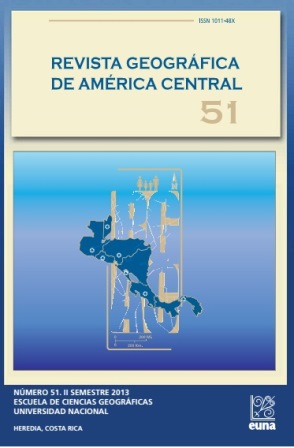GEOGRAPHIC ANALYSIS OF SOCIO-ENVIRONMENTAL SEGREGATION OF THE CITY OF SAN JOSE
Keywords:
Socio-environmental-segregation - urban ecology - urban geography - public spacesAbstract
One of the main problems that arises due to urban growth is limiting the populations access to basic resources to meet their needs. The city of San Jose is no exception to this phenomenon, proof of this is the level of socio-environmental segregation as is presented below. Socio-environmental segregation is determined by the accessibility and availability of public spaces, public green spaces and the provision of social facilities, allowing us to analyze the approach to urban ecology and from a geographic perspective to determine the sites with higher or lower level of socio-environmental segregation. With the verification and relation of these variables, we can statistically determine the current level of segregation in the districts of San Jose, which allows us to define, territorially, “social zones” present in the city.
References
Bosque, J. y Moreno, A. (2004). Sistemas de Información Geográfica y
Localización Óptima de Instalaciones y Equipamiento. RA-MA. Madrid. España.
Buzai, G. (2006). Análisis socioespacial con sistemas de información geográfica. Lugar Editorial. Buenos Aires. Argentina.
Burgess, E. (1925).“The Growth of the City: An Introduction to a Research Project” The City. Chicago: TheUniversity of Chicago Press, 1925, 1967. Recuperado de: http://www.tsjugephd.com/PCC_Courses/Articles_files/file_Burgess_The_Growth_of_the_city.pdf consulta el 22 de mayo de 2011.
Cutillas, E. (2011). Cambios demográficos y delimitación de las áreas sociales en la ciudad de Valencia (España). Aposta, Revista de CienciasSociales (49). Universidad de Alicante. España. Recuperado de: http://www.apostadigital.com/revistav3/hemeroteca/cutillas1.pdf
consultado 16 de abril de 2011.
Dematteis, G. (1998). “Suburbanización y periurbanización. Ciudades anglosajonas y ciudades latinas”, Moclús, F. J. (ed.), La ciudad dispersa. Barcelona: Centre de Cultura Contemporánea de Barcelona, pp.17-33.
Instituto Nacional de Estadística y Censos (2012). Censo de Población y Vivienda 2011.San José, Costa Rica.
Mac Gregor, I. (2011). Avances de la ecología urbana en Latinoamérica: un enfoque ornitológico. En memoria. I Simposio de Ecología Urbana 5to Congreso Nacional de Biología. San José, Costa Rica.
Observatorio del Desarrollo, Universidad de Costa Rica (2009). Costa Rica: Índice de Competitividad Cantonal. Promotora del Comercio Exterior de Costa Rica. San José, Costa Rica.
Quesada, F. (2003) “El ambiente de la elite”. Modernidad, segregación urbana y transformación arquitectónica: San José, Costa Rica, 1890- 1935. Scripta Nova. Revista electrónica de geografía y ciencias sociales, VII (146) Barcelona: Universidad de Barcelona. Recuperado
de: http://www.ub.edu/geocrit/sn/sn-146(027).htm
Polèse, M., Perez, S. y Barragan, C. (1994). La Ecología Humana de las
Ciudades en Desarrollo: Ensayo de Geografía Residencial de Puebla,
México. Texto presentado en el coloquio internacional: Las ciudades
y las regiones urbanas frente a la modernización. Universidad
Autónoma de Puebla. Puebla México, pp. 9-11.
Programa Estado de la Nación (2007). Duodécimo informe Estado de la Nación en Desarrollo Humano Sostenible. Programa Estado de la Nación. San José, Costa Rica. ISBN 9968-806-36-6.
Puyol, R., Estébanez, J., y Méndez, R. (1995): Geografía Humana. Madrid: Editorial Cátedra (3ª ed.).
Roman, M (2013). Segregación residencial socioeconómica en la Gran Área Metropolitana de Costa Rica niveles y patrones entre 1984 y 2000.Revista Población y Salud en Mesoamérica. 10 (2), ISSN-1659-020.
Rueda, S. (2005). Visiones de la ciudad: del urbanismo de Cerdá a la ecología urbana. Barcelona: Agencia d’Ecologia Urbana. Recuperado
de: http://bcnecologia.net/documentos/Visiones%20ciudad.pdf
Salgado, M., Romero, H., Vásquez, A. y Fuentes, C. (2009). Segregación Socio-Ambiental en espacios urbanos. Estudio de caso en la comuna de Peñalol. Cuadernos de trabajo, 1, 14-32. Subprograma Domeyko, Política, Pobreza y Exclusión Social, Universidad de Chile. Recuperado de: http://captura.uchile.cl/jspui/bitstream/2250/10288/1/
Segregaci%C3%B3n%20Socioambiental%20en%20espacios%20
urbanos.%20Estudio%20de%20caso%20en%20la%20comuna%20
de%20Pe%C3%B1alol%C3%A9n.pdf
Vargas, M. (2002). Segregación Urbana, Social y Ambiental en Santiago y la Violencia en la Ciudad. Tesis de Magíster en Asentamientos Humanos y Medio Ambiente (MHM). Universidad de Costa Rica.
Downloads
How to Cite
Issue
Section
License
Proposed policy for journals offering Open Access
Authors publishing their works in the Journal acknowledge and agree to the following terms:
a) Authors retain the copyrights to their works and guarantee the Journal the right to be the first to publish their works, under the Creative Commons License Attribution-NonCommercial-ShareAlike 4.0 International, CC BY-NC-SA 4.0 International (https://creativecommons.org/licenses/by-nc-sa/4.0/deed.es), which allows others to share works upon complying with the acknowledgment of authorship and mention of the Journal as the original publisher of the work.
b) Authors are permitted to separately establish additional agreements for the non-exclusive distribution of the official edition of the work published in the Journal (for example, authors may desire to place the work in an institutional repository or incorporate it into a book that is to published elsewhere) so long they acknowledgment to recognize the Journal as the original publisher. The aforementioned additional agreements must respect the terms of the non-profit character and sharing philosophy of the original license (CC BY-NC-SA 4.0 International, https://creativecommons.org/licenses/by-nc-sa/4.0/deed.es).
c) Authors are encouraged to archive the post-print or editor/PDF version in Open Access repositories.






 REVGEO is licensed under https://creativecommons.org/licenses/by-nc-sa/4.0/deed.es
REVGEO is licensed under https://creativecommons.org/licenses/by-nc-sa/4.0/deed.es
.svg_4.png)

_(1).png)
_(1)_(1)_(1)_1.png)
(2)(1)(1)(1).png)
